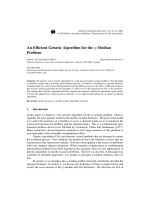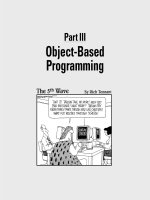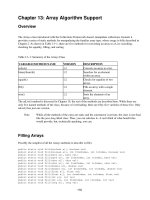Array Algorithm Support
Bạn đang xem bản rút gọn của tài liệu. Xem và tải ngay bản đầy đủ của tài liệu tại đây (35.17 KB, 8 trang )
Chapter 13: Array Algorithm Support
Overview
The Arrays class introduced with the Collections Framework doesn't manipulate collections. Instead, it
provides a series of static methods for manipulating the familiar array type, whose usage is fully described in
Chapter 2. As shown in Table 13−1, there are five methods for converting an array to a List: searching,
checking for equality, filling, and sorting.
Table 13−1: Summary of the Arrays Class
VARIABLE/METHOD NAME VERSION DESCRIPTION
asList() 1.2 Converts an array to a list.
binarySearch() 1.2 Searches for an element
within an array.
equals() 1.2 Checks for equality of two
arrays.
fill() 1.2 Fills an array with a single
element.
sort() 1.2 Sorts the elements of an
array.
The asList() method is discussed in Chapter 15; the rest of the methods are described here. While there are
only five named methods of the class, because of overloading, there are fifty−five varieties of those five. Only
asList() has just one version.
Note While all the methods of the class are static and the constructor is private, the class is not final
like the java.lang.Math class. Thus, you can subclass it—I can't think of what benefit this
would provide, but, technically speaking, you can.
Filling Arrays
Possibly the simplest of all the Arrays methods to describe is fill().
public static void fill(boolean a[], boolean val)
public static void fill(boolean a[], int fromIndex, int toIndex, boolean val)
public static void fill(byte a[], byte val)
public static void fill(byte a[], int fromIndex, int toIndex, byte val)
public static void fill(char a[], char val)
public static void fill(char a[], int fromIndex, int toIndex, char val)
public static void fill(double a[], double val)
public static void fill(double a[], int fromIndex, int toIndex, double val)
public static void fill(float a[], float val)
public static void fill(float a[], int fromIndex, int toIndex, float val)
public static void fill(int a[], int val)
public static void fill(int a[], int fromIndex, int toIndex, int val)
public static void fill(long a[], long val)
170
public static void fill(long a[], int fromIndex, int toIndex, long val)
public static void fill(short a[], short val)
public static void fill(short a[], int fromIndex, int toIndex, short val)
public static void fill(Object a[], Object val)
public static void fill(Object a[], int fromIndex, int toIndex, Object val)
Of course, with eighteen versions of this method, a little explanation is necessary. Basically, the fill() method
allows you to take a single element and fill up an entire array or a subset of that array with copies of the single
element. Of the eighteen varieties of this method, two exist for each of the eight primitives types and two for
working with Object arrays.
The simplest case is when you do not specify a range. For instance, the following demonstrates how to create
an integer array of ten elements and fill it with the number 100.
int array[] = new int[10];
Arrays.fill(array, 100);
If you were to then examine the contents of each element of the array, you would find 100 in every cell.
Tip Remember from Chapter 2 that the elements of new, unfilled arrays are initialized with a default value. If
you've forgotten what they are, see Table 2−1.
If, instead of trying to fill an entire array, you only wanted to fill a subset, you can specify a range of cells to
fill with a from−index and a to−index. When specifying the indices, the from−index is included in the cells to
change and the to−index is not included. When the indices are not provided, you can think of the from−index
as being zero and the to−index as being the array length. This means that if the from−index is the same as the
to−index, nothing will change because the range is empty. For instance, the following will change the contents
of cells 3, 4, and 5 of the earlier created array to 50.
Arrays.fill(array, 3, 6, 50);
As shown in Figure 13−1, elements 0, 1, and 2 are still 100. Elements 3, 4, and 5 are now 50, and elements 6
through 9 are still 100.
Figure 13−1: Results of filling an array of primitives with Arrays.fill().
Warning If the from−index is after the to−index, an IllegalArgumentException is
thrown. If either index is outside the range of indices for the array, then an
ArrayIndexOutOfBoundsException is thrown.
There are two questions that may arise when working with fill(). When you try to fill an array with a different
type, how are data conversions handled? And when working with objects, is it the same object reference in
every cell, or is it a clone or copy of the object?
In the case of data conversions, the fill() method itself doesn't do anything special to convert between different
primitive types. Essentially, if the compiler permits the conversion, no casting is necessary. Otherwise, you'll
have to manually add a type cast like (type) within the method call. For instance, the following requires a cast
to fill the byte array as the constant 4 is an integer, even though you can do byte b = 4;:
byte array2[] = new byte[10];
Arrays.fill(array2, 4); // illegal
Chapter 13: Array Algorithm Support
171
Arrays.fill(array2, (byte)4); // Okay
The other case that requires a little extra thought has to do with filling arrays with objects. When filling an
object array, the fill() method will copy the same object reference to every cell in the array:
Object array[] = new Object[10];
Object anObject = ...;
Arrays.fill(array, anObject);
After filling the array, if you then change that one reference, the attributes of the object in every cell in the
array will be changed. See Figure 13−2 for a visualization of this description.
Figure 13−2: How Arrays.fill() fills an array with the same object reference.
Warning If you try to fill() an object array with something that is not assignment compatible
with the array type, an ArrayStoreException will be thrown. As the method only
accepts an Object[ ] and an Object argument, it's up to you to ensure the type safety of
the call, not the compiler.
Checking Equality
The second Arrays method is the equals() method:
public static boolean equals(boolean a[], boolean array2[])
public static boolean equals(byte array1[], byte array2[])
public static boolean equals(char array1[], char array2[])
public static boolean equals(double array1[], double array2[])
public static boolean equals(float array1[], float array2[])
public static boolean equals(int array1[], int array2[])
public static boolean equals(long array1[], long array2[])
public static boolean equals(short array1[], short array2[])
public static boolean equals(Object array1[], Object array2[])
Note The MessageDigest class provides an is Equals() method. This was the only predefined mechanism to
check byte array equality before the addition of the Collections Framework with the Java 2 platform.
While it might seem weird to have used this method to compare byte arrays that weren't message
digests, it worked.
There are nine versions of this method, one for each primitive type and one for objects.
Checking Equality
172
Two arrays are defined to be equal if they are the same length and if the elements at corresponding positions
in both arrays are equal.
For primitive arrays, this equates to the following: array1.length == array2.length and array1[i] == array2[i]
for all i from 0 to array length‘.
For objects arrays, this is almost the same with only a couple of differences. The lengths must still be the
same (array1.length == array2.length). However, to check for equality of elements, the equals() method is
used instead of the == check: array1[i].equals(array2[i]) for all i from 0 to array length‘. And two elements
are equal if they are both null.
There is one other special case worth mentioning: if both array references are null, the arrays are equals.
Tip To check for equality of a subset of elements in one or both arrays, you'll need to make a copy of the
array, most likely with the arraycopy() method of System described in Chapter 2.
Sorting Arrays
The sorting methods of the Arrays class are probably the most frequently used methods of this class. We'll
look at the different varieties of sorting primitives and objects separately as the differences are a bit more
significant than with filling and checking for equality.
Primitive Arrays
There are fourteen methods to sort arrays of primitive values in the Arrays class:
public static void sort(byte array[])
public static void sort(byte array[], int fromIndex, int toIndex)
public static void sort(char array[])
public static void sort(char array[], int fromIndex, int toIndex)
public static void sort(double array[])
public static void sort(double array[], int fromIndex, int toIndex)
public static void sort(float array[])
public static void sort(float array[], int fromIndex, int toIndex)
public static void sort(int array[])
public static void sort(int array[], int fromIndex, int toIndex)
public static void sort(long array[])
public static void sort(long array[], int fromIndex, int toIndex)
public static void sort(short array[])
public static void sort(short array[], int fromIndex, int toIndex)
Note There is no support for sorting arrays of boolean values.
Like equality checking with Arrays.equals(), you can sort the entire array, or perform a sort on a subset of the
elements. The from−index is the first cell to sort and is 0 when not specified. The to−index is one beyond the
end of cells to sort, or array.length when not specified. When the two indices are the same, nothing is sorted.
Warning If the from−index is after the to−index, an IllegalArgumentException is
thrown. If either index is outside the range of indices for the array, then an
ArrayIndexOutOfBoundsException is thrown.
Sorting Arrays
173
To sort an array of primitives, just pass the array into one of the sort() methods and you're basically done. The
following demonstrates the creation and sorting of an array of integers:
int array[] = {2, 5, −2, 6, −3};
Arrays.sort(array);
After performing the sort, the array elements will be, in order, “, ’, 2, 5, 6. Sorting a subset is just as
simple:
int array2[] = {2, 5, −2, 6, −3, 8, 0, −7, −9, 4};
Arrays.sort(array, 3, 7);
Sorting elements 3, 4, 5, and 6 in our new array produces the following order: 2, 5, ’, 3, 0, 6, 8, —, 9, 4.
(Notice that the sorted elements are in italic.)
Note According to the class documentation, the sorting algorithm is a tuned quicksort algorithm
that was adapted from the article "Engineering a Sort Function," Software−Practice and
Experience 23, no. 11 (November 1993).
Object Arrays
While sorting arrays of primitives is very straightforward, sorting arrays of objects can require a little more
work. There are four sort() methods for sorting objects:
public static void sort(Object array[])
public static void sort(Object array[], int fromIndex, int toIndex)
public static void sort(Object array[], Comparator c)
public static void sort(Object array[], int fromIndex, int toIndex, Comparator c)
The first two methods work similar to the primitive array sorting methods. Pass in an array of objects and
they'll be sorted. The objects in the array passed in, though, must implement the Comparable interface. If the
objects don't implement the interface, when you try to sort the array, a ClassCastException will be thrown at
runtime. To demonstrate, the following program will sort the elements passed in from the command line and
then print them out:
import java.util.*;
public class SortTest {
public static void main(String args[]) throws Exception {
Arrays.sort(args);
for (int i=0, n=args.length; i<n; i++) {
System.out.println(args[i]);
}
}
}
When run with a command line of one two three four five, the results of running the program will be:
five
four
one
three
two
Object Arrays
174









